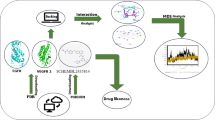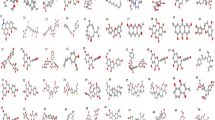Abstract
Dovitinib, a hydrophobic kinase inhibitor (KI), is lipophilic anticancer agent that forms water-soluble complexes with cyclodextrins (CDs). However, dovitinib’s very low intrinsic solubility hampers the complex formation and, consequently, the CD solubilization. The aim of the study was to enhance the CD solubilization through formation of more water soluble dovitinib salts. When dovitinib is unionized (i.e. at pH above its pKa value) the phase-solubility profile of the binary dovitinib/γCD complex is of Bs-type with K1:1 of 684 M−1. Then the complex has limited solubility in water. Upon protonization, (i.e. at pH below the pKa value) the solubility of dovitinib was increased but the increase was dependent on the negatively charged counter ion. Citrate, acetate, EDTA and chloride resulted in the greatest solubility enhancement and, thus, were selected to further studies. The ternary phase-solubility profiles of dovitinib/γCD/counter ion were also of Bs-type while those of dovitinib/HPγCD/counter ion and dovitinib/SBEγCD/counter ion were of AN-type. The counter ions had greater solubilizing effect in SBEγCD solutions than in γCD and HPγCD solutions. This is due to the influence of charge-charge interaction between the positively charged dovitinib and negatively charged SBEγCD. Citrate was the most effective counter ion particularly in aqueous SBEγCD solutions. The complexation was verified by NMR. The highest dovitinib flux through semi-permeable membrane was observed from medium containing dovitinib/CDs/citrate complexes. In conclusion, citrate provided the highest dovitinib solubilization and complexation.





Similar content being viewed by others
Data availability
All data generated or analyzed during this study are available within this published article and its supplementary information files.
References
Porta, C., Giglione, P., Liguigli, W., Paglino, C.: Dovitinib (CHIR258, TKI258): structure, development and preclinical and clinical activity. Future Oncol. (London, England). 11(1), 39–50 (2015). https://doi.org/10.2217/fon.14.208
Benet, L.Z.: The role of BCS (biopharmaceutics classification system) and BDDCS (biopharmaceutics drug disposition classification system) in drug development. J. Pharm. Sci. 102(1), 34–42 (2013). https://doi.org/10.1002/jps.23359
Herbrink, M., Schellens, J.H., Beijnen, J.H., Nuijen, B.: Inherent formulation issues of kinase inhibitors. J. Controlled Release 239, 118–127 (2016). https://doi.org/10.1016/j.jconrel.2016.08.036
Remko, M., Boháč, A., Kováčiková, L.: Molecular structure, pKa, lipophilicity, solubility, absorption, polar surface area, and blood brain barrier penetration of some antiangiogenic agents. Struct. Chem. 22(3), 635–648 (2011). https://doi.org/10.1007/s11224-011-9741-z
Praphanwittaya, P., Saokham, P., Jansook, P., Loftsson, T.: Aqueous solubility of kinase inhibitors: I the effect of hydrophilic polymers on their γ-cyclodextrin solubilization. J. Drug Deliv. Sci. Technol. 55, 101462 (2020). https://doi.org/10.1016/j.jddst.2019.101462
Serajuddin, A.T.: Salt formation to improve drug solubility. Adv. Drug Deliv. Rev. 59(7), 603–616 (2007). https://doi.org/10.1016/j.addr.2007.05.010
Loftsson, T., Magnusdottir, A., Masson, M., Sigurjonsdottir, J.F.: Self-association and cyclodextrin solubilization of drugs. J. Pharm. Sci. 91(11), 2307–2316 (2002). https://doi.org/10.1002/jps.10226
Saokham, P., Muankaew, C., Jansook, P., Loftsson, T.: Solubility of cyclodextrins and drug/cyclodextrin complexes. Molecules (2018). https://doi.org/10.3390/molecules23051161
Brewster, M.E., Loftsson, T.: Cyclodextrins as pharmaceutical solubilizers. Adv. Drug Deliv. Rev. 59(7), 645–666 (2007). https://doi.org/10.1016/j.addr.2007.05.012
Saokham, P., Loftsson, T.: γ-Cyclodextrin. Int. J. Pharm. 516(1), 278–292 (2017). https://doi.org/10.1016/j.ijpharm.2016.10.062
Loftsson, T., Saokham, P., Sá Couto, A.R.: Self-association of cyclodextrins and cyclodextrin complexes in aqueous solutions. Int. J. Pharm. 560, 228–234 (2019). https://doi.org/10.1016/j.ijpharm.2019.02.004
Loftsson, T., Stefansson, E.: Cyclodextrins and topical drug delivery to the anterior and posterior segments of the eye. Int. J. Pharm. 531(2), 413–423 (2017). https://doi.org/10.1016/j.ijpharm.2017.04.010
Messner, M., Kurkov, S.V., Jansook, P., Loftsson, T.: Self-assembled cyclodextrin aggregates and nanoparticles. Int. J. Pharm. 387(1), 199–208 (2010). https://doi.org/10.1016/j.ijpharm.2009.11.035
Loftsson, T., Duchêne, D.: Cyclodextrins and their pharmaceutical applications. Int. J. Pharm. 329(1), 1–11 (2007). https://doi.org/10.1016/j.ijpharm.2006.10.044
Loftsson, T., Jarho, P., Masson, M., Jarvinen, T.: Cyclodextrins in drug delivery. Expert Opin. Drug Deliv. 2(2), 335–351 (2005). https://doi.org/10.1517/17425247.2.1.335
Munro, I.C., Newberne, P.M., Young, V.R., Bar, A.: Safety assessment of gamma-cyclodextrin. Regul. Toxicol. Pharmacol. 39(1), S3–S13 (2004). https://doi.org/10.1016/j.yrtph.2004.05.008
Loftsson, T., Brewster, M.E.: Cyclodextrins as functional excipients: methods to enhance complexation efficiency. J. Pharm. Sci. 101(9), 3019–3032 (2012). https://doi.org/10.1002/jps.23077
Jansook, P., Ogawa, N., Loftsson, T.: Cyclodextrins: structure, physicochemical properties and pharmaceutical applications. Int. J. Pharm. 535(1–2), 272–284 (2018). https://doi.org/10.1016/j.ijpharm.2017.11.018
Kurkov, S.V., Loftsson, T.: Cyclodextrins. Int. J. Pharm. 453(1), 167–180 (2013). https://doi.org/10.1016/j.ijpharm.2012.06.055
Okimoto, K., Rajewski, R.A., Uekama, K., Jona, J.A., Stella, V.J.: The interaction of charged and uncharged drugs with neutral (HP-beta-CD) and anionically charged (SBE7-beta-CD) beta-cyclodextrins. Pharm. Res. 13(2), 256–264 (1996). https://doi.org/10.1023/a:1016047215907
Zia, V., Rajewski, R.A., Stella, V.J.: Effect of cyclodextrin charge on complexation of neutral and charged substrates: comparison of (SBE)7M-beta-CD to HP-beta-CD. Pharm. Res. 18(5), 667–673 (2001). https://doi.org/10.1023/a:1011041628797
Gupta, D., Bhatia, D., Dave, V., Sutariya, V., Varghese Gupta, S.: Salts of therapeutic agents: chemical, physicochemical, and biological considerations. Molecules (Basel, Switzerland) (2018). https://doi.org/10.3390/molecules23071719
Mura, P., Faucci, M.T., Manderioli, A., Bramanti, G.: Multicomponent systems of econazole with hydroxyacids and cyclodextrins. J. Incl. Phenom. Macrocyclic Chem. 39(1), 131–138 (2001). https://doi.org/10.1023/A:1008114411503
Gould, P.L.: Salt selection for basic drugs. Int. J. Pharm. 33(1), 201–217 (1986). https://doi.org/10.1016/0378-5173(86)90055-4
Tong, W.Q., Whitesell, G.: In situ salt screening—a useful technique for discovery support and preformulation studies. Pharm. Dev. Technol. 3(2), 215–223 (1998). https://doi.org/10.3109/10837459809028498
Cerreia Vioglio, P., Chierotti, M.R., Gobetto, R.: Pharmaceutical aspects of salt and cocrystal forms of APIs and characterization challenges. Adv. Drug Deliv. Rev. 117, 86–110 (2017). https://doi.org/10.1016/j.addr.2017.07.001
Cruz-Cabeza, A.J.: Acid–base crystalline complexes and the pKa rule. CrystEngComm 14(20), 6362–6365 (2012). https://doi.org/10.1039/C2CE26055G
Lee, H.: Pharmaceutical Industry Practices on Genotoxic Impurities. CRC Press, London (2014)
Higuchi, T., Connors, K.A.: Phase-solubility techniques. In: C.N.R. (ed.) Advances in Analytical Chemistry and Instrumentation, vol. 4. pp. 117–212. Wiley, New York (1965)
Fenyvesi, E., Vikmon, M., Szeman, J., Redenti, E., Delcanale, M., Ventura, P., Szejtli, J.: Interaction of hydroxy acids with β-cyclodextrin. J. Incl. Phenom. Macrocyclic Chem. 33(3), 339–344 (1999). https://doi.org/10.1023/A:1008094702632
Ueno, A., Takahashi, K., Osa, T.: Photocontrol of catalytic activity of capped cyclodextrin. J. Chem. Soc. Chem. Commun. 3, 94–96 (1981). https://doi.org/10.1039/C39810000094
Redenti, E., Szente, L., Szejtli, J.: Drug/cyclodextrin/hydroxy acid multicomponent systems. Properties and pharmaceutical applications. J. Pharm. Sci. 89(1), 1–8 (2000).
Muankaew, C., Jansook, P., Stefansson, E., Loftsson, T.: Effect of gamma-cyclodextrin on solubilization and complexation of irbesartan: influence of pH and excipients. Int. J. Pharm. 474(1–2), 80–90 (2014). https://doi.org/10.1016/j.ijpharm.2014.08.013
Amiri, S., Amiri, S.: Cyclodextrins: Properties and Industrial Applications. Wiley, New York (2017)
Dufour, G., Evrard, B., de Tullio, P.: Rapid quantification of 2-hydroxypropyl-β-cyclodextrin in liquid pharmaceutical formulations by 1H nuclear magnetic resonance spectroscopy. Eur. J. Pharm. Sci. 73, 20–28 (2015). https://doi.org/10.1016/j.ejps.2015.03.005
Luna, E.A., Vander Velde, D.G., Tait, R.J., Thompson, D.O., Rajewski, R.A., Stella, V.J.: Isolation and characterization by NMR spectroscopy of three monosubstituted 4-sulfobutyl ether derivatives of cyclomaltoheptaose (beta-cyclodextrin). Carbohydr. Res. 299(3), 111–118 (1997). https://doi.org/10.1016/s0008-6215(97)00006-2
Maeda, H., Tanaka, R., Nakayama, H.: Inclusion complexes of trihexyphenidyl with natural and modified cyclodextrins. SpringerPlus 4(1), 218 (2015). https://doi.org/10.1186/s40064-015-0986-7
Praphanwittaya, P., Saokham, P., Jansook, P., Loftsson, T.: Aqueous solubility of kinase inhibitors: II the effect of hexadimethrine bromide on the dovitinib/γ-cyclodextrin complexation. J. Drug Deliv. Sci. Technol. 55, 101463 (2020). https://doi.org/10.1016/j.jddst.2019.101463
Ribeiro, L., Carvalho, R.A., Ferreira, D.C., Veiga, F.J.: Multicomponent complex formation between vinpocetine, cyclodextrins, tartaric acid and water-soluble polymers monitored by NMR and solubility studies. Eur. J. Pharm. Sci. 24(1), 1–13 (2005). https://doi.org/10.1016/j.ejps.2004.09.003
Djedaïni, F., Lin, S.Z., Perly, B., Wouessidjewe, D.: High-field nuclear magnetic resonance techniques for the investigation of a β-cyclodextrin:indomethacin inclusion complex. J. Pharm. Sci. 79(7), 643–646 (1990). https://doi.org/10.1002/jps.2600790721
Zhao, R., Tan, T., Sandstrom, C.: NMR studies on puerarin and its interaction with beta-cyclodextrin. J. Biol. Phys. 37(4), 387–400 (2011). https://doi.org/10.1007/s10867-011-9221-0
Zabiszak, M., Nowak, M., Taras-Goslinska, K., Kaczmarek, M.T., Hnatejko, Z., Jastrzab, R.: Carboxyl groups of citric acid in the process of complex formation with bivalent and trivalent metal ions in biological systems. J. Inorg. Biochem. 182, 37–47 (2018). https://doi.org/10.1016/j.jinorgbio.2018.01.017
Zelenina, T.E., Zelenin, O.Y.: Complexation of citric and tartaric acids with Na and K ions in aqueous solution. Russ. J. Coord. Chem. 31(4), 235–242 (2005). https://doi.org/10.1007/s11173-005-0083-5
Acknowledgements
The authors are grateful for the support provided by the University of Iceland.
Funding
This research was granted by Icelandic center of Research (RANNÍS).
Author information
Authors and Affiliations
Contributions
Pitsiree Praphanwittaya: investigation, formal analysis, data curation, writing—original draft. Phatsawee Jansook: Methodology. Thorsteinn Loftsson: Funding acquisition, Supervision, Writing—original draft.
Corresponding author
Ethics declarations
Conflict of interest
The authors declare that there is no conflict of interest. The work was performed by Pitsiree Praphanwittaya and will be part of her PhD dissertation.
Additional information
Publisher's Note
Springer Nature remains neutral with regard to jurisdictional claims in published maps and institutional affiliations.
Rights and permissions
About this article
Cite this article
Praphanwittaya, P., Jansook, P. & Loftsson, T. Aqueous solubility of kinase inhibitors: III the effect of acidic counter ion on the dovitinib/γ-cyclodextrin complexation. J Incl Phenom Macrocycl Chem 98, 57–67 (2020). https://doi.org/10.1007/s10847-020-01009-7
Received:
Accepted:
Published:
Issue Date:
DOI: https://doi.org/10.1007/s10847-020-01009-7




